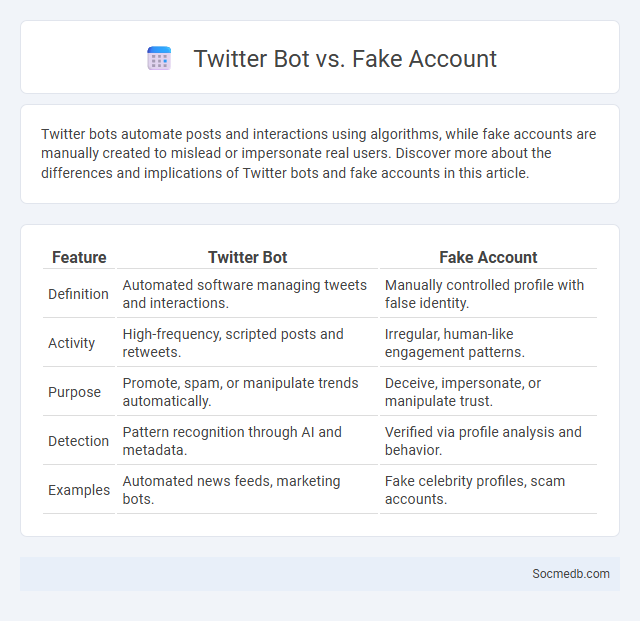
Photo illustration: Twitter Bot vs Fake Account
Twitter bots automate posts and interactions using algorithms, while fake accounts are manually created to mislead or impersonate real users. Discover more about the differences and implications of Twitter bots and fake accounts in this article.
Table of Comparison
| Feature | Twitter Bot | Fake Account |
|---|---|---|
| Definition | Automated software managing tweets and interactions. | Manually controlled profile with false identity. |
| Activity | High-frequency, scripted posts and retweets. | Irregular, human-like engagement patterns. |
| Purpose | Promote, spam, or manipulate trends automatically. | Deceive, impersonate, or manipulate trust. |
| Detection | Pattern recognition through AI and metadata. | Verified via profile analysis and behavior. |
| Examples | Automated news feeds, marketing bots. | Fake celebrity profiles, scam accounts. |
Understanding Twitter Bots: Definition and Purpose
Twitter bots are automated accounts designed to simulate human interaction by posting tweets, retweeting, liking, and following other users based on programmed algorithms. These bots serve various purposes, including amplifying marketing campaigns, spreading news or misinformation, and influencing public opinion during political events. Advanced bot networks can mimic genuine user behavior to evade detection, making it essential to analyze activity patterns and metadata for accurate identification.
What is a Fake Account on Twitter?
A fake account on Twitter is a profile created with false or misleading information, often used to impersonate someone else, spread misinformation, or manipulate public opinion. These accounts may use stolen photos, fabricated names, and deceptive content to appear legitimate and gain followers or influence. Protecting Your online presence involves recognizing such accounts to avoid interactions that could compromise your security or trust in the platform.
Differentiating Bots from Human Users
Distinguishing bots from human users on social media platforms relies on analyzing behavioral patterns such as posting frequency, interaction diversity, and language complexity. Advanced machine learning algorithms assess anomalies in activity timing, content originality, and network connections to accurately identify automated accounts. Ensuring the authenticity of Your social media interactions enhances trustworthiness and improves overall user experience by reducing spam and misinformation.
Key Features of Twitter Bots
Twitter bots automate posting, liking, retweeting, and following activities to increase engagement and reach. They analyze hashtags, keywords, and user interactions to respond in real time, optimizing content delivery and audience targeting. Your social media strategy can benefit from these bots by enhancing brand visibility and driving traffic efficiently.
How to Spot Fake Accounts on Twitter
Identifying fake accounts on Twitter involves examining profile details such as incomplete bios, generic or stolen profile pictures, and low follower counts with high following ratios. Check for unnatural tweet patterns, including repetitive content, excessive retweets, or automated posting times that suggest bot activity. Verifying interactions by analyzing engagement quality and cross-referencing linked websites or other social profiles can further reveal authenticity.
Exploring the Types of Bots on Social Media
Social media platforms host various types of bots, including chatbots that simulate human conversation, spam bots that disseminate unsolicited content, and influencer bots designed to artificially boost follower counts. These automated programs can impact your online experience by amplifying misinformation, inflating engagement metrics, and influencing public opinion. Understanding the distinct functionalities and purposes of social media bots is essential for recognizing their presence and mitigating their effects.
Impact of Bots and Fake Accounts on Twitter
Bots and fake accounts on Twitter significantly distort public discourse by amplifying misinformation and manipulating trending topics. These automated profiles can sway public opinion, interfere with genuine user engagement, and undermine trust in the platform's content authenticity. Protecting Your experience requires increased platform vigilance and advanced detection algorithms to identify and remove malicious bot activities swiftly.
Security Risks: Bots vs. Fake Accounts
Social media platforms face significant security risks from both bots and fake accounts, which can spread misinformation, manipulate engagement, and compromise user privacy. Bots automate malicious activities such as phishing attacks or spam, while fake accounts often impersonate real users to deceive and exploit Your personal or professional network. Implementing robust verification measures and utilizing advanced AI detection tools are essential to mitigate these threats and protect Your online presence.
Twitter’s Policies on Bots and Fake Accounts
Twitter's policies strictly prohibit the creation and use of bots that engage in spam, manipulation, or deception, ensuring platform integrity. Fake accounts are banned if they impersonate individuals or entities or manipulate conversations through coordinated activity. To protect Your experience, Twitter enforces penalties including account suspension for policy violations related to automated or fraudulent behaviors.
Best Practices for Identifying Bots and Fake Accounts
Effective identification of bots and fake accounts on social media relies on analyzing behavioral patterns such as rapid posting frequency, excessive follower-to-following ratios, and generic profile information. Utilizing automated tools like Botometer or AI-driven algorithms enhances detection by examining metadata, engagement authenticity, and network connections. Continuous monitoring combined with user reports helps maintain accurate account verification, reducing misinformation and promoting genuine interactions across platforms.
 socmedb.com
socmedb.com